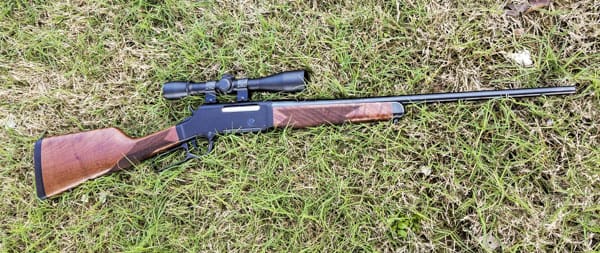
The first three calibers released by Henry Repeating Arms for its box-fed “Long Ranger” lever-action rifle are .308 Win, .243 Win, and .223 Rem/5.56 NATO. Why those calibers? Because they’re the calibers their customers asked for.
I absolutely love the .308 version I reviewed earlier this year. I hear there’ll be additional calibers released, including .338 Federal and 6.5 Creedmoor. But for now, I was happy to get the Long Ranger in its smallest caliber, .223/5.56.
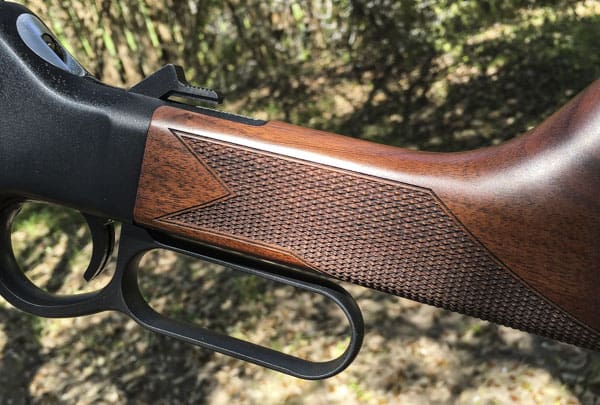
Opening up the familiar Henry box, I was [still] impressed by the Ranger’s looks. The quality of the wood on the .308 version was superb — far better than you’ll find on most bolt guns at this price.

This wood on this particular gun isn’t quite as good as the previous Long Ranger, but that’s simply the variation in a natural product. It’s close, with the last rifle probably being at the top of its grade in quality wood and this one being closer to the middle. The checkered American walnut stock and foregrip has a little bit less wavy figure in it, but with the lightest bit of oil rubbed in, it really shines up nicely.

The metal finish is outstanding, as is the overall design and build of the gun. It’s the little details that set this gun apart, like the curve of the bottom of the receiver and how the magazine fits into it. A machined-and-chromed steel bolt with a 6-lug rotary head is driven into a rear extension of the barrel. The finish of all the internals is absolutely excellent, and the aforementioned rotating locking bolt shines and moves like clockwork inside the receiver.
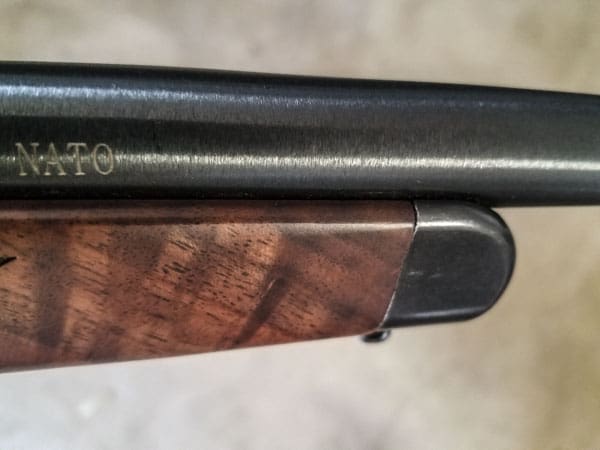
I noted in the last review that the wood-to-metal fit on the forend was good, but not perfect. I was being nit picky with that one, but this one is worse than that. The forestock wood is not fit well, with some slight machine marks on the metal.
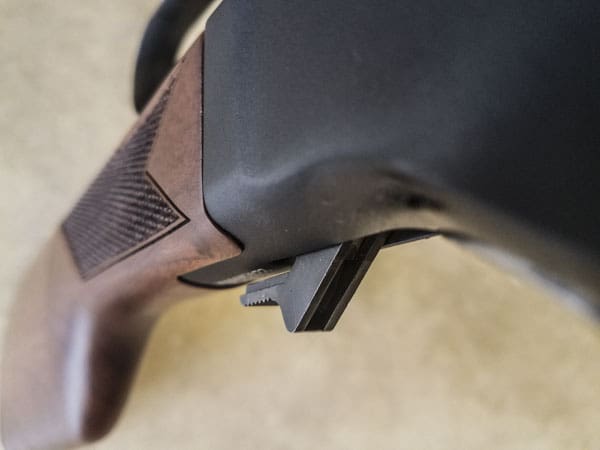
The stock is also oversized where the receiver tang meets it, and hangs over the receiver as well. That’s a shame and out-of-place on a rifle that has a great design, that’s otherwise executed extremely well.
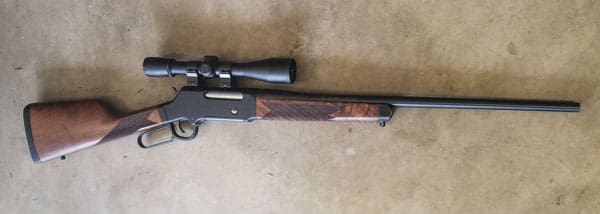
Henry now offers the Long Ranger with or without iron sights. I think the gun works better without sights.

The rifle comes scope ready, drilled and tapped with a Skinner rail set already mounted. For this test, I mounted the exact same scope as I did for the last review. All I had to do was unscrew the scope from the base of the .308 rifle and screw it right on to the scope mount on the .223, no other adjustments to the mount were necessary.

It’s pretty clear that the Long Ranger was set up to be scope mounted. Low to medium rings put the optic right in front of my eye, while keeping a solid cheek-stock weld. The shorter grip and much higher comb add the surety that this is an optic-based gun.
Without the glass mounted, I tried to look right over the mount, as if I had sights set up on it. I’d either have to move my face farther back on the stock to bring my eye down, or mash my cheek in there. As it is, this is one of the very few lever guns that deserves to have quality glass sitting on top of it. A fixed 6x or 10x for whopping the prairie dogs would be ideal.
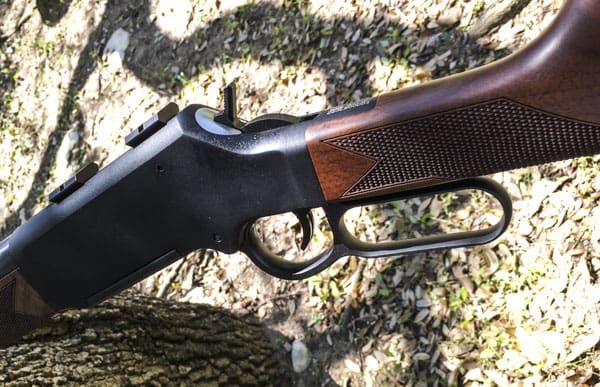
None of the Long Ranger models have an external safety. Like traditional Henry lever guns, the Long Ranger employs the proven in-hammer sliding transfer bar safety. It’s perfectly safe to carry in the field with a round chambered and the hammer down. When you pull the trigger, the rifle will fire. Then and only then.
With the once-over of the .223 Long Ranger complete, it was time to head to the range to see if it lived up to the .308 version’s performance. The first time I opened the action to lube the gun, it certainly felt different.

The first Long Ranger I had all but sprung open with only a slight pull of the lever. This one didn’t; it took a good pull to get the gun to open.
Following my established protocols, I ran a bore snake through the gun, and liberally sprayed Rogue American Apparel’s Gun Oil throughout the now open action and barrel. I usually let the gun sit like that for an hour or so. This time I just set about loading the magazine.
After filling the magazine, I closed the action, put my thumb on the trigger to hold it there, and gently squeezed the trigger. Nothing. I pulled back on the trigger harder. Nothing. I looked down closely at the receiver and realized it wasn’t quite closed. It was very close, but not all the way.

A millimeter more on the handle, and the gun fired. Read that carefully. Yup, I never took my finger off the trigger, and I wasn’t paying attention to the now very oily hammer. After shooting my first deer 37 years ago, I just had my first — and only — negligent discharge.
The muzzle was pointed in a safe direction and the round hit the berm behind my target. The muzzle was well in front of me (or anyone else on the line) but I wasn’t looking at the target directly as the gun fired, and didn’t intend for it to do so. That’s a negligent discharge.
Of course, I cocked the gun and squeezed the trigger, so the firearm itself behaved exactly as it was supposed to. It happened because I wasn’t paying attention to the gun. I was feeling for it to fully close; I expected it to feel like the rifle I’d shot before. Mea culpa. Complacency kills.
Unfortunately, this gun doesn’t have quite the same easy-to-open-and-close action as its .308 brother. Once that action gets started, it flies open and back, cycling extremely fast. But it takes a tug to get it open, and you have to be sure to fully close it. After 300 rounds, it was considerably better. My 12-year-old son had no problem cycling the action.
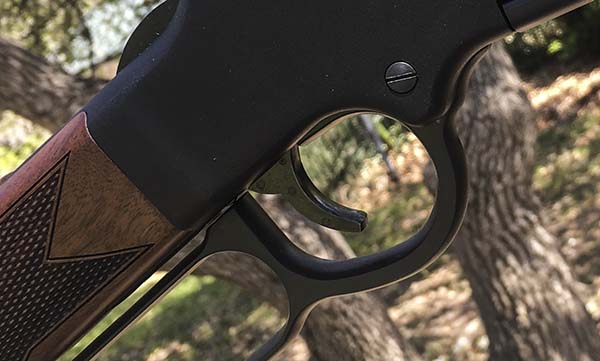
The trigger, however, is just as outstanding as the .308 — far better than any of my stock bolt guns. The trigger breaks cleanly and neatly at 4 pounds. There’s just a small — as in maybe 2mm — amount of take-up prior to the break, without any grit or mush.
As for reliability, the .223/5.56 functions with the same boring monotony as the .308. Maybe even better. Through 300 rounds I had zero problems loading, firing, or cycling any ammo I put through the gun. Never a sticky bolt.
I shot everything from surplus 55-grain FMJs, to 77-grain OTMs, with lead-nosed HPs and anything else I could find thrown in between. I’d be perfectly comfortable taking this rifle on any (caliber appropriate) hunt, 100 percent sure that it will perform when I need it to.
The hallmark of a varmint caliber like this one is (or should be) accuracy. A small hole will sink a big ship, but it had better be in the right place. Henry Rifle’s motto is “Made in America, or Not Made at All.” That extends to their in-house-made barrels — ensuring both reliable supply as well as the level of accuracy I’ve come to expect from the last Long Ranger.
The .223/5.56 20-inch 1:9 twist barrel didn’t particularly like the 55-grain FMJs, printing an average of 1.7-inch five-round groups at 100 yards from bags. That was likely the round. The accuracy kept improving as I fired, especially with the heavier rounds. The 64-grain Winchester Power Point round I use to cull deer printed at 1.2 inches, and the 77-grain OTM round printed an average of 1 inch on the nose, with very little deviation.
All in all, I fired 60 rounds from bags for accuracy testing without cleaning the rifle prior to or during the shooting. I was really surprised at that level of accuracy in a lever gun with my last review, and now I know I can rely on it with the smaller caliber as well.

Beyond bench accuracy, this rifle excels from the kneel and standing positions. Like all rifles, it greatly benefit from an actual shooter’s sling. Standing unslung at 100 yards, I had little trouble hitting an 8-inch circle. Slung up, I could stretch that out to 300 yards.
The Long Ranger, in any of its calibers, is a breeze to fire in any position, with great balance. The recoil’s so light you can watch your round strike the target even at 50 yards. It just doesn’t buck at all.
Balance and the plain old “shootability” of this rifle makes the Long Ranger comfortable to carry and shoot anywhere. If you’re looking for a light-shooting, accurate gun this is an outstanding rifle. That it’s not an AR or a bolt gun makes it that much better.
Specifications: Henry Long Ranger Rifle
Action Type: Lever Action
Caliber: .223 Remington and 5.56 NATO
Capacity: 5 rounds
Length: 40.5″
Barrel Length: 20″ Round
Length of Pull: 14″
Rate of Twist: 1:9
Weight: 7 lbs.
Stock: Straight grip checkered American Walnut with buttpad
Other features: Sling swivel studs, solid black rubber recoil pad
MSRP: $1014.95
Ratings (out of five stars):
Style, Fit and Finish * * * *
The Long Ranger’s bluing is well executed, the checkering is both functional and appealing, and the wood is very good for this price range. If you can choose between a couple, you’re likely to find some true gems. One star off for the wood-to-metal fitment.
Accuracy * * * * *
Like the last Long Ranger, this lever-action rifle outperforms almost all of my factory bolt guns, save one that’s much heavier and more expensive. It shoots any round well, and some very well, all the way down consistent MOA performance.
Reliability * * * * *
Zero issues with any round in any condition with a variety of weights, manufacturers, and overall lengths.
Overall * * * *
In any caliber, the Long Ranger has proven to be an easy, reliable shooter. Plus there’s the appeal of a MOA-accurate rifle that looks like it won the West can’t be denied.
More from The Truth About Guns:
New from Wild West Guns: Browning BLR Takedown Combo Rifle




Excellent review, About something other than a n AR.
Sorry to have to tell you this, but unless it has a military, two-stage trigger, that 2mm of “take up” is called “creep”, and it is NOT supposed to be there. Most firearms today do suffer from it, and a competent gunsmith can fix it, but it is not even close to the same thing as an actual two stage trigger, in which the (real this time) take up is much longer than a couple millimetres, and also much softer than the actual trigger pull weight. Real take up of a two stage does not move the sear engagement surfaces, whereas creep does.
I’m not sorry to have to tell you this, but you are mistaken and your own comment proves it. This rifle’s trigger is does not have creep. It is pre-travel, or take-up. You are right when you say the difference is that the take-up does not have much resistance, if any at all, and does not move the sear. This rifle’s trigger is an example of that. I would hope that you would not waste your money on a gunsmith to fix a trigger that is functioning as intended.
I just installed a Timney 2 stage trigger with the long first stage in my wife’s AR and I have to say the difference between a first stage of a 2 stage trigger and ‘take up’ seem to be identical. In the Timney there’s probably more like 4mm of take up but it’s very light. Supposed to be 2+2lbs but feels more like 1+3 to me. The stock trigger btw was a nice crisp 10 poundish single stage.
Unless Timney doesn’t know anything about triggers…
Timney are the long standing trigger experts. I have no personal experience with this exact rifle, and if this is take-up, rather than creep, then so be it. I was only trying to point out the differences between the two. 2mm is quite little for a real take up, but if the sear surfaces don’t move then it is take up and not creep. An inspection of the FCG would let one know. Still, it is to be watched out for, as many firearms today suffer from it. Many manufacturers make the sear engage to excess for legal reasons.
Most of these Henry rifles have triggers that are as good or better than anything you would tweak , actually the design could be quite dangerous to the unawares and there is nothing in their manuals to warn a shooter of the fact . Once the bullet is seated the trigger is but a bump and I mean a very slight one . Be cautious and practice and then enjoy a beautiful USA made , very accurate , out of the box , firearm . Five stars all the way from me .
‘I just had my first, and only, negligent discharge.’ – Personally I wouldn’t consider that a ‘negligent’ discharge since keeping the weapon pointed in a safe direction while trying to troubleshoot a problem with it is hardly negligent. I think there is room in the lexicon for a term like ‘unintended discharge’.
Lever guns without tube magazines just look funky, but I do find a .338 Fe deral version intriguing.
Picky, picky… fine, we’ll say “unintentional” discharge. And weren’t we just discussing NDs just yesterday? Like I said then, it happens to most of us at least once.
As for the Henry, I cannont die until I get a Big Boy .44 to match my Ruger Vaquero. Hopefully I’ll get one with a few years to spare before I shuffle off this mortal coil.
Not that there aren’t negligent discharges. Most of them are. Just in the absence of negligence like this case, I think it’s OK to call it an unintended discharge.
Kind of leaning toward a Big Boy carbine in .357 but I can’t decide if I want brass or steel. You’d think the steel would be more than $20 cheaper.
Stop thinking about it, get it if possible. I wish I would have gotten my .357 in brass sooner. Just had it out to the range this past weekend and was ringing the 200 meter 12″ gong after two shots of walking it in. Boringly consistent but fun to pull the trigger and realize it takes almost twice the mount of time for the bullet to connect. Hangs above the patio door in the living room, work of art. Its my only gun I leave out to admire. Just a fun rifle to shoot.
Negligent Discharge. I think JWT summed it up properly. He had his finger on the trigger when he was not ready to fire. Broke one of the rules. Glad to see he can admit he isn’t perfect.
I’d have probably made a bigger deal of the fact that the action can appear to be ready to fire when it isn’t. I could see this same thing happening to other people who might not be as disciplined about keeping the muzzle pointed in a safe direction when they are fiddling with it. Typically you have to break at least two rules to get someone hurt.
The root of the problem was that the g un was not functioning quite properly and as long as the other 3 rules were followed I wouldn’t call it negligence on JWT’s part. I doubt he would have made the same mistake if he were sitting at home and not at the range with the muz zle pointed downrange. Still, I’m sure it gave him quite a start.
What? Gov wants to a change or add a new category or a new category for “un”inteneded discharge” Gov, you want to change the from a “negligent discharge”
What kind of Einstein wanna be are you
You discharge a firearm while its not pointed at the identified target, its plain ass “negligent”. Someone investigate this character. His firearms need to be taken from him, for that’s the last character you want owning a firearm; unintended discharge is totally irresponsible and one is lucky if they don’t take someone out, due to Unintended.
Idiot comes to mind.
@#$%$# 6.5 Creedmore. I have .260s, .264s, 6.5 x 55s,6.5 x 300WBY and Grendels. And Creedmore is the one that takes off? I hate this sport sometimes…
just look at it as an oppurtunity to round out your collection of 6.5s.
This will likely take the place of the Mini 14 on my wishlist.
This would be an interesting suppressor host if it were threaded. Nice gun.
A lever action sporting a silencer just seems wrong.
Just add some pic rails and it will look okay again…
Keymod floating forearm and collapsible stock. And can I get that in a bullpup? Having said that from a position of cover and concealment, I do loves me some Henrys.
Henry offers 2 different rail options for this on their Henry Pride site.
I disagree with that sentiment. Theodore Roosevelt himself had a Winchester 1894 fitted with a Maxim silencer.
Call me a purist, but I am slightly put off by the scope. My 30-30 doesn’t have a scope. Lever rifles shouldn’t have scopes. Then again, maybe it’s because they aren’t supposed to be chambered for varmint rounds. That’s just MHO,FWIW. What do I know.
MOST lever action rifles were chambered for pistol rounds (.44 Henry rimfire, .44 WCF were the most common, along with .32-20 and .25-20) until JMB came along and built an action strong enough to handle rifle rounds. And if you go looking at old Winchesters, I bet you find a slew of them chambered in .32-20, which I consider to be a varmint round.
You are right!! ALL rifles should have Iron sights, especially Lever-action
+1 on the wish for a threaded-barrel version, even though I live in a state where silencers/sound suppressors are banned. We’re still allowed to have flash suppressors (on guns other than the “evil black gun with the scary initials”), and I think a flash suppressor or linear compensator is almost a necessity on any 5.56/.223 rifle with a barrel 20″ or shorter. My favorite is the BRT Covert Comp, which also acts as a linear compensator (directing the noise and muzzle blast forwards, away from the shooter), but a standard A1 or A2 flash suppressor would be easy to throw on this lever-gun if only the barrel were threaded. If I took a lever-action rifle to my gunsmith to get threaded, he’d just laugh at me, which is why I want a factory-threaded option (he’s already laughed at me for wanting to get my .223 bolt guns threaded)!
A ‘smith laughing about a customers request is cutting off his nose to spite his face. As long as the mod is safe, and legal, it’s his own business that is suffering. Some people make a living being laughed at, so don’t fret it. Lots of people were ridiculed for their ideas, but got the last laugh…Ford, Edison, etc.. Having a barrel threaded is probably in the top 5 of requests to any gunsmith.
The photo makes the fore-stock cap look kind of crushed in. With the stiff action, I wonder if this rifle took a couple of good knocks somewhere before it got to you.
I’ve seen Henry rifles arrive DOA before (action issue, refused to go into battery), but never one that had that obvious of a surface finish problem right out of the box.
I couldn’t help but notice that the barrel did not look so “perfect in the area around the rollmarks, the metal looks quite roughly finished and almost as a patina setting in. It may just be me, but I never saw a Henry look like that before.
Hope they produce a 6.5 Grendel version soon!
Don’t need one but I sure want one.
Oh, and that price! Personally I’d pay $5 more and get a Browning BLR with a perfect finish and fit. At $1019 MSRP it seems to have that “cool” factor down we like in a rifle.
Exactly what I was thinking, why pay a grand for a rifle that’s so incompletely finished that it leaves the factory with a rough flat bead blasted looking surface on the receiver and visible lathe grooves on the barrel, both of which means there was either zero or almost zero polishing of metal surfaces before the rifle was blued. Add to that the incomplete/poorly fitted buttstock and foregrip and faulty fire control that enables discharge of the rifle when the lever closes the action and you’ve got a really $#!tty built unsafe firearm with a MSRP about the same as a nicely fitted, finished, and proven Browning BLR.
WTF?
This Henry rifle doesn’t even come close to Rossi or current production Marlin rifles.
The Browning BLR is a lovely lever gun, available in a wide range of calibers, with straight or pistol grip stock, in blued or stainless, and they even have takedown versions.
However, some gunsmiths hate their complexity, and there is near universal griping about heavy pull of the factory triggers. There is one guy identified as a “BLR trigger guru”, Neil Jones of Saegertown PA. (http://www.neiljones.com)
I have no idea what he charges for a trigger job, but better factor it in if you want to compare the BLR to the Henry.
Any over $1,000 firearm best turn into a pizza and beer after midnight, and be back ready to shoot by noon.
Way over priced, I would consider this poor finish, and fit.
very sharp looking COWBOY GUN, that seems not ready for the WEST, based on this report. recommend a return, a replace or a refund. sad.
You are right, ALL rifles should have iron sights
Street price $750-800.
I can’t find one thing wrong with my new 243 long ranger. Fit and finish 100 percent. Beautiful stock! A tack driver!
For $768 @ Buds I say NO thanks to a Browning!
For that kind of money I think I would rather see a little better fit and finish on it.
I enjoyed reading your review of the Henry .223
Long Ranger. What type of sling would you recommend to compliment the the rifle?
Also, do you think a Weaver 3×9, 40/44 scope would be sufficient?
Thank you for your input.
Just acquired a Henry 223 without sights.
Fit and finish you discussed I fortunately haven’t observed. Very clean mating of wood to metal and no metal scratching.
I also have Henry’s 30-30 Brass, a beauty and a Henry 357 hard case. I mention these as their actions are so much more fluid than the 223. Have you had the same experience
Also any recommendation on 1/2 buckhorn iron sights as a backup. I still go into the back country and sometimes the lugging of a scope isn’t what I want?
Thanks by the way. Your thoroughness is appreciated. Don
Hi Don,
I also bought the Henry 223 without sights, and then wished I’d bought the model with sights. There’s no easy way to add sights to the sightless model (there is no way to attach a front sight, you’d have to find someone to weld one on front sight).
If you don’t want to lug around a scope, I suggest using a lightweight red dot sight. A pistol red dot would only weigh one, two, or three ounces.
Even a large rifle red dot, such as an Eotech, would only weigh about 8 ounces, compared to a scope plus rings that would weigh about 20 ounces.
I sold my Henry Long Ranger. Compared to other lever-action rifles, it just didn’t seem to balance right, too long (40.5″ long) and too heavy once you add a scope, and like you, I got the sightless model, which was a mistake. If you get the one with sights, you can get an improved rear sight from Skinner Sights, but if you get the sightless model, unless you’re a welder, you can’t add sights.
Gear up as your favorite Delsin Rowe Vest. Slim Fit Leather Jackets brings this iconic jacket from animation to reality, especially for all the fans of this video game. Delsin Rowe is the main protagonist and playable character, a young Native-American man who later realizes he’s a Conduit with special powers.
I have the Long Ranger 223 without sights; use both a red/green dot and scope but…
Looking for after market “iron sights”. Any suggestions as Henry has not been responsive. Thanks. Don
Skinner Sights sells receiver-mounted rear sights for the Henry Long Ranger.
But you’ll need a front sight to use with that.
If your Long Ranger didn’t come with a front sight, either ask a gunsmith to make one for you, or sell your rifle and buy the sighted version of the Henry Long Ranger.